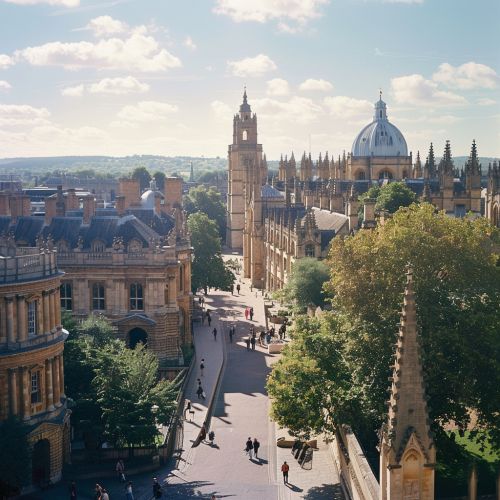Oxford Movement: Difference between revisions
(Created page with "== Origins and Early Development == The Oxford Movement was a religious movement that originated within the Church of England in the 19th century. It was initiated by a group of Anglican clergymen based at the University of Oxford in 1833. The movement was also known as the Tractarian Movement, after the publication of a series of texts called the ''Tracts for the Times''. <div class='only_on_desktop image-preview'><div class='image-preview-loader'></div></d...") |
No edit summary |
||
| Line 2: | Line 2: | ||
The [[Oxford Movement]] was a religious movement that originated within the [[Church of England]] in the 19th century. It was initiated by a group of Anglican clergymen based at the University of Oxford in 1833. The movement was also known as the Tractarian Movement, after the publication of a series of texts called the ''[[Tracts for the Times]]''. | The [[Oxford Movement]] was a religious movement that originated within the [[Church of England]] in the 19th century. It was initiated by a group of Anglican clergymen based at the University of Oxford in 1833. The movement was also known as the Tractarian Movement, after the publication of a series of texts called the ''[[Tracts for the Times]]''. | ||
[[Image:Detail-77849.jpg|thumb|center|A view of the University of Oxford, where the Oxford Movement originated]] | |||
The Oxford Movement was characterized by a desire to return to the [[High Church]] traditions of the Anglican Church, which were rooted in the rituals and liturgical practices of the early Christian Church. The movement's leaders, including [[John Henry Newman]], John Keble, and Edward Bouverie Pusey, sought to combat what they saw as the increasing secularization of the Church of England, and to reaffirm the Church's status as a branch of the [[Holy Catholic Church]]. | The Oxford Movement was characterized by a desire to return to the [[High Church]] traditions of the Anglican Church, which were rooted in the rituals and liturgical practices of the early Christian Church. The movement's leaders, including [[John Henry Newman]], John Keble, and Edward Bouverie Pusey, sought to combat what they saw as the increasing secularization of the Church of England, and to reaffirm the Church's status as a branch of the [[Holy Catholic Church]]. | ||
Revision as of 01:03, 8 May 2024
Origins and Early Development
The Oxford Movement was a religious movement that originated within the Church of England in the 19th century. It was initiated by a group of Anglican clergymen based at the University of Oxford in 1833. The movement was also known as the Tractarian Movement, after the publication of a series of texts called the Tracts for the Times.

The Oxford Movement was characterized by a desire to return to the High Church traditions of the Anglican Church, which were rooted in the rituals and liturgical practices of the early Christian Church. The movement's leaders, including John Henry Newman, John Keble, and Edward Bouverie Pusey, sought to combat what they saw as the increasing secularization of the Church of England, and to reaffirm the Church's status as a branch of the Holy Catholic Church.
Theological and Liturgical Principles
The Oxford Movement was underpinned by a number of key theological and liturgical principles. These included a belief in the Apostolic Succession, the idea that the authority of the Church is derived from the apostles, and a commitment to the sacraments as means of grace. The movement also emphasized the importance of personal holiness and asceticism, and promoted the revival of ancient liturgical practices.
The Tractarians, as the leaders of the movement were known, also held a high view of the Church as a divine institution, and rejected the idea that the Church was a mere creation of the state. They argued for the independence of the Church from secular authorities, and for the authority of the Church to be derived from its apostolic succession, rather than from the state.
Impact and Legacy
The Oxford Movement had a significant impact on the Church of England and on Anglicanism more broadly. It led to a revival of High Church practices and liturgy, and influenced the development of Anglo-Catholicism, a tradition within Anglicanism that emphasizes the Catholic heritage of the Church.
The movement also had a significant cultural impact. It influenced the Gothic Revival in architecture, and contributed to a renewed interest in medieval literature and art. The movement's emphasis on personal holiness and asceticism also had a profound effect on the development of Christian spirituality in the 19th century.
The Oxford Movement also had a significant impact on other Christian denominations. The principles of the movement influenced the development of the Anglo-Catholic tradition within Anglicanism, and also had an impact on the Roman Catholic Church, particularly in the area of liturgical reform.
Criticisms and Controversies
The Oxford Movement was not without its critics. Many within the Church of England were uncomfortable with the movement's emphasis on High Church practices and its rejection of the Church's ties to the state. The movement was also criticized for its perceived Romanizing tendencies, and some of its leaders, including Newman, eventually converted to Roman Catholicism.
Despite these controversies, the Oxford Movement has continued to exert a significant influence on Anglicanism and on Christianity more broadly. Its emphasis on the sacraments, on personal holiness, and on the Church as a divine institution continue to be influential in many Christian traditions.
